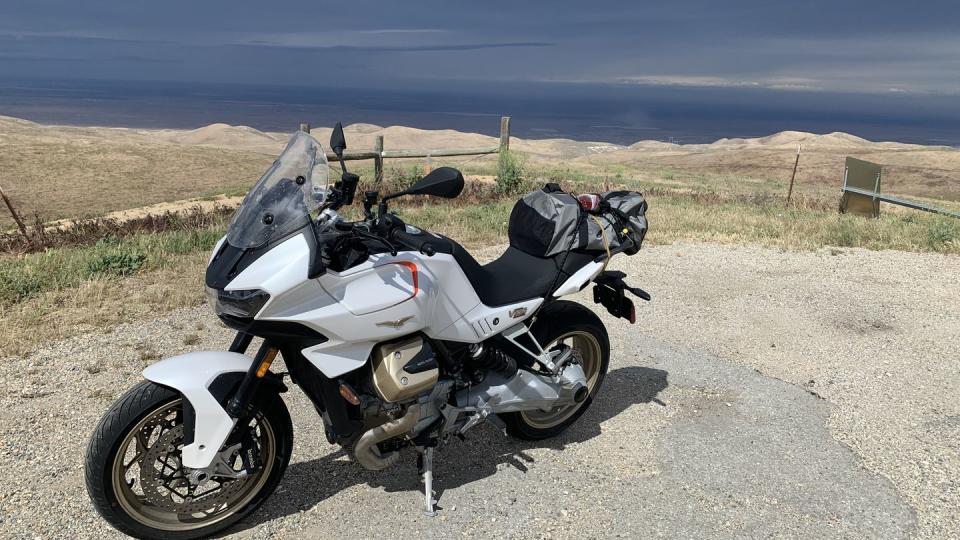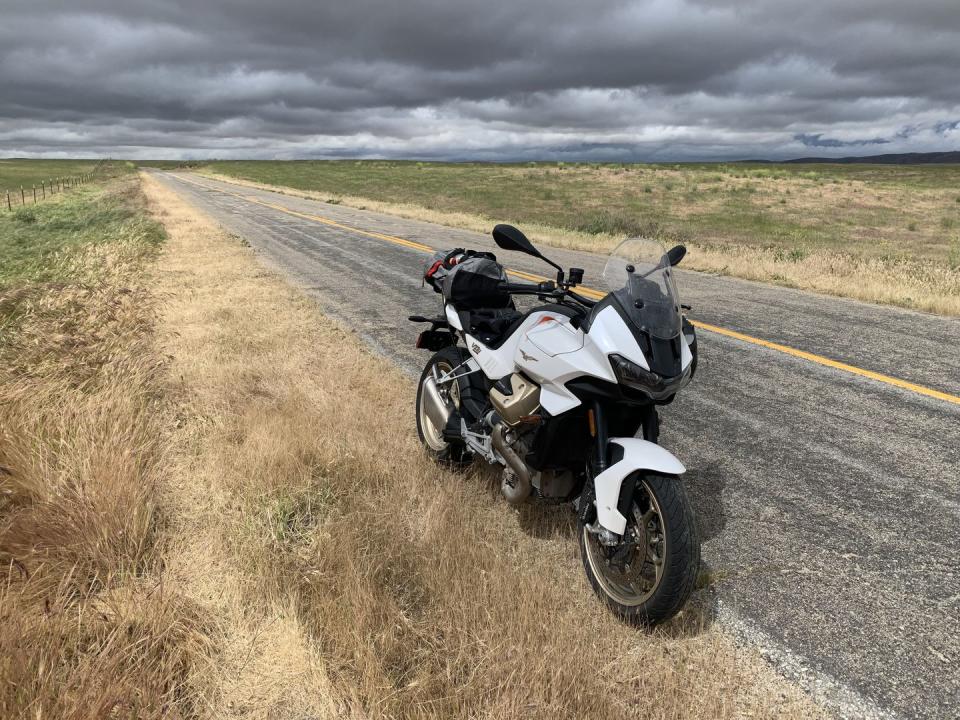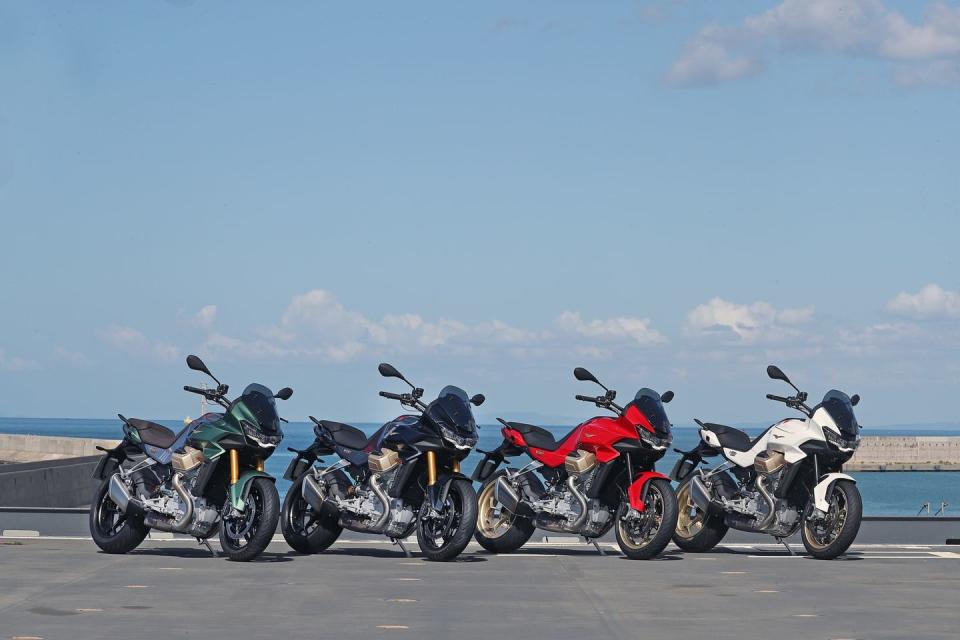Moto Guzzi V100 Mandello Shows Character Counts

The Moto Guzzi V100 Mandello is a sport touring bike loaded with character.
The 1048cc transverse 90-degree V Twin makes 115 hp at 8,750 rpm.
Base price is $15,490.
The mighty Moto Guzzi V100 Mandello is a new Sport Touring bike from Italy that offers character galore and yet can still hold together on an over-700-mile ride up and down the California Coast.
Here’s how I know.
I needed something to get me 350 miles from Los Angeles to Carmel for the Quail Motorcycle Gathering, and I had already ridden all the touring bikes the world has ever known. As I was scouring the lists of existing motorcycles over 50cc to find an appropriate ride, I remembered Moto Guzzi and its all-new V100 Mandello.
Four years earlier I had ridden the V85TT adventure bike when that product was new, so I was hoping to try out the new Mandello. Connections were established and next thing I knew I was pulling out of the fenced-in yard of Moto Club Santa Monica and heading north, having dropped off my own, personal, carbureted Suzuki SV650 as collateral.

The heart of the new Goose is its 1,048cc 90-degree transverse-mounted V-Twin. If you haven’t seen this engine configuration, consider it something like a BMW flat-twin but with the cylinder heads tilted up 45 degrees and poking out into the air flow like pinwheels.
Both heads are still in the position they used to be back when these were air-cooled and needed the cooling, but they are now liquid-cooled. The cylinders themselves are now twisted a quarter turn so that the exhaust headers are on the outside, lined with heat shields so you don’t melt your Gore-Tex pantalones.
The engine is four inches shorter overall than the old unit, with a shaft drive spinning the rear wheel. It makes a powerful 115 hp at 8,700 rpm and 77.5 lb-ft of torque at 6,750, which is a lot for a bike that weighs 512.6 pounds.
While peak power does indeed come in way up at almost 9,000 rpm, this bike definitely feels happier cruising at about 4,000 revs. Anything more and… well, I guess there’s no reason not to rev that high, but I stayed at 4 grand most of the time. It just felt right.
There is a counter-rotating shaft in there to balance out the rotation of the crankshaft, but the revs still felt a little rattly, not like a longitudinal 90-degree V-Twin as on my SV650 or on a Ducati, but still rattlier than I would have expected given all the vibration countermeasures. Owners call this “character” and it’s one of the things they love.
Moto G says the new bike will return 50 mpg, but at the speeds I took on my ride, I got a consistent 41 mpg seemingly no matter what I did or how fast I rode. From the 4.5-gallon tank, that would give me 185 miles range the way I was going, but 225 miles if you actually got the 50 mpg promised.
The next most characterful thing on this bike has to be the active aero. If you put it in Rain or Sport modes and you go over about 35 mph or so, flaps deploy from the tank sides to route air away from your lap. At first I assumed it would be a gimmick but, after a while I started to depend on it for a slightly more comfortable riding experience.
Guzzi says it reduces turbulence by 23%. It does, I would say, thus transcending gimmickry.

Other things were not on my base-model bike. Had an upscale S model been available, I could have tried out the Ohlins semi-active EC 2.0 suspension that adjusts the dampers depending on which ride mode you’re in. Likewise, the Quickshift transmission feature was not on my base model, forcing me to suffer the indignity of clutch operation the whole week.
I managed just fine, thanks. Clutch engagement and operation were largely painless and easy, though I have been spoiled by BMW clutches.
My bike did have a six-axis IMU to sort out any slip or handling slights. It also had cornering ABS, and cruise control, the latter which took a while to figure out but once figured, worked fine.
On the long, flat highway stretches I tucked behind the electrically adjustable windscreen and wailed on the throttle. But in the nice twisty bits like State Route 58 west of McKittrick, California, one of the best twisty roads in the world, the bike showed its sporting character.
It wasn’t as confident as pure sport bikes I’ve had the pleasure to ride—like the Honda CBR1000RR, BMW S 1000 RR, or the Ducati Panigale V2—but it is more versatile and comfortable than those. Long rides are full of tradeoffs. It was nonetheless capable in those and many other curves I encountered, showing its compromising nature with a reassuring ease.
It also did well in the pouring rain I encountered coming back from El Quail, set in Rain mode and never slipping, even in the thin beige mud that coursed across a few stretches of remote ranchland I chose instead of the more pedestrian Hwy. 101 or—gawdforbid—I-5.
(Let me just praise also the Dainese gear I wore the whole way back in that rain. It was worth every nickel of sticker price.)
What else competes with this characterful carrier? I’ve been lucky enough to ride the Yamaha Tracer 9 GT, the Suzuki GSX-S-1000GT+, and BMW S 1000 XR, bikes which I also rode on these very same roads. The Moto Guzzi felt heavier than those. Indeed, the Yamaha is listed at about 50 pounds lighter, and the Suzuki and BMW about 15 pounds less.
The competitor engines also felt—this is objective—smoother. Yet Moto Guzzi enthusiasts, so-called Guzzisti (or perhaps Geese?), aren’t splitting hairs to that degree. They love the way their mounts feel, the way they respond in corners, and the way they look with those big heads poking up and out like startled guard dogs.
So you have to pick which of all the traits you value most. And of those, many find the Goose is grandest.

 Yahoo Autos
Yahoo Autos 